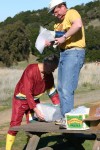Sunol Regional Wilderness
Date: (Sun.) Apr. 15, 2012
Location: Sunol, CA
Event Director: - 408.599.9709
Course Setters: Gary Carpenter, Damian Swift
Type: B; Standard event with courses for beginners through advanced. The wildflowers should be beautiful!
Course Setters' Notes
By Damian Swift and Gary Carpenter
Terrain and Hazards
Sunol, as always, will have relatively steep terrain with lots of open areas, making navigation fairly easy, but with more physical effort required. The recent rains have made for soft ground that is easier on the feet when contouring steep hillsides. The footing is generally pretty good, and the grass is short, allowing easy travel in open areas.
Poison oak is present, so we recommend protective clothing and lotions for people who are sensitive to it. In general the courses avoid poison oak areas, but there are a few places where pushing through a few meters of low-to-medium height plants offers a good route choice. There are no thistles to speak of, and just a touch of burrs left from last year's grassland plants.
We noticed several unmapped cow paths, so be aware that not all paths you see are on the map. Conversely, some mapped "dirt" roads in open areas are covered with grass and not as obvious at other times of the year.
On the Sunol map, green O’s and X’s both indicate distinctive trees, O being evergreen and X being deciduous.
There are several barbed-wire fence crossings on the advanced courses, including Orange. Use caution when crossing these, and roll under whenever possible. Please respect the Out-of-Bounds areas indicated on the map — the advanced courses come near some of these areas.
There is a horseback riding event going on the same day as our BAOC event. Please give equestrians the right of way, and avoid startling them by fast, unexpected movements such as jumping suddenly onto a trail from behind forest cover. If you encounter a horseback rider on the trail, stop moving, stand on the downhill side, and speak calmly to the rider asking for instructions on what he/she would like you to do.
As for wildlife: Be aware of ticks, and inspect your clothing and body for them at the end of your course. We found more than one tick hitchhiker during course setting. Wild turkeys are abundant in this area. If you stay for control pick-up, there is a good chance you will see the bobcat that prowls the trails between the Finish and Registration areas in the early evenings.
Courses
Starts for the White, Yellow, and Orange courses are in the Registration area.
The advanced courses have a remote start that is about a 10-minute walk or 5-minute jog up a hill, to help reduce course climb.
Here are the details for the courses:
Course Length Climb Controls Difficulty
White 2.1 km 60 m 10 Easy: all on trails
Yellow 2.5 km 110 m 10 Advanced beginner: travel on trails,
controls off trail
Orange 3.3 km 160 m 10 Intermediate: cross-country but with
longer handrail option
Brown 2.8 km 160 m 13 Technically advanced, moderate effort
Green 4.1 km 315 m 15 Technically advanced, hard effort
Red 5.4 km 380 m 17 Technically advanced, very hard effort
Blue 6.0 km 470 m 19 Technically advanced, extremely hard effort
White and Yellow Courses
The initial portion of the White and Yellow courses follows a paved road south and across the river on a vehicle bridge. An equestrian trail crosses the paved road in two locations and also crosses the vehicle bridge. Since there is an equestrian event being held concurrently with our meet, it is imperative that we follow correct protocol when encountering horseback riders (see above). No equestrians are expected after you are east of the bridge.
Orange Course
The Orange course is fast, very runnable, with little to no poison oak. Cattle are present in the area of control #5. Many of the black X’s (man-made features) shown in the western portion of the course are old wooden power poles that have been cut off about 3 feet above the ground.

